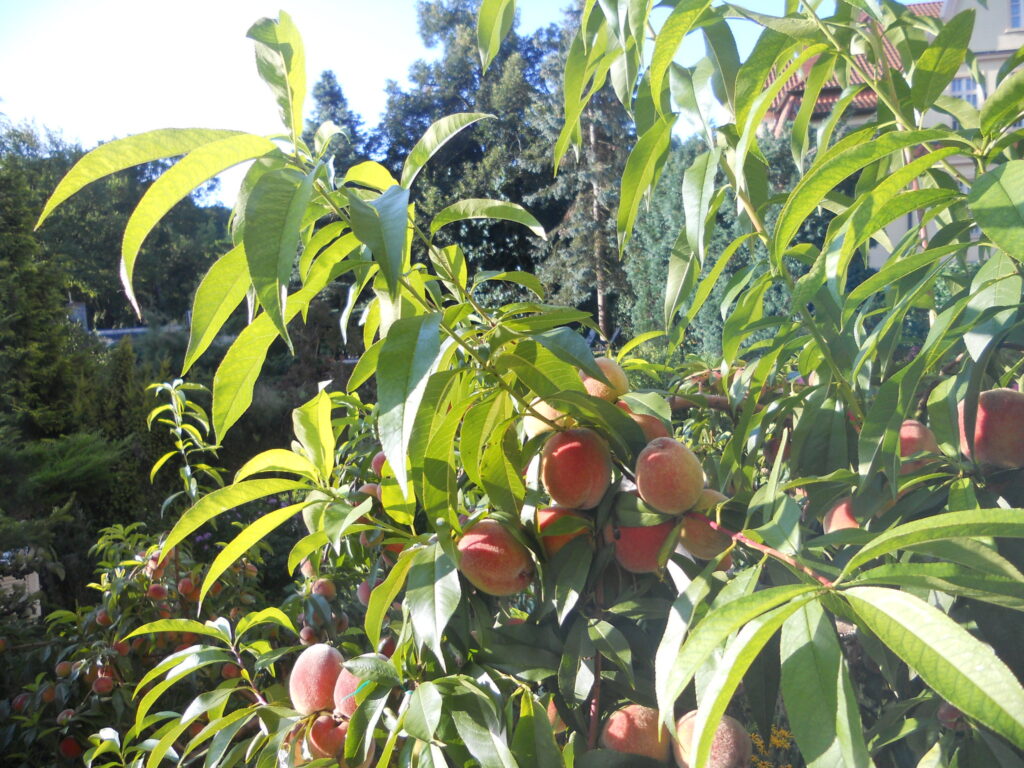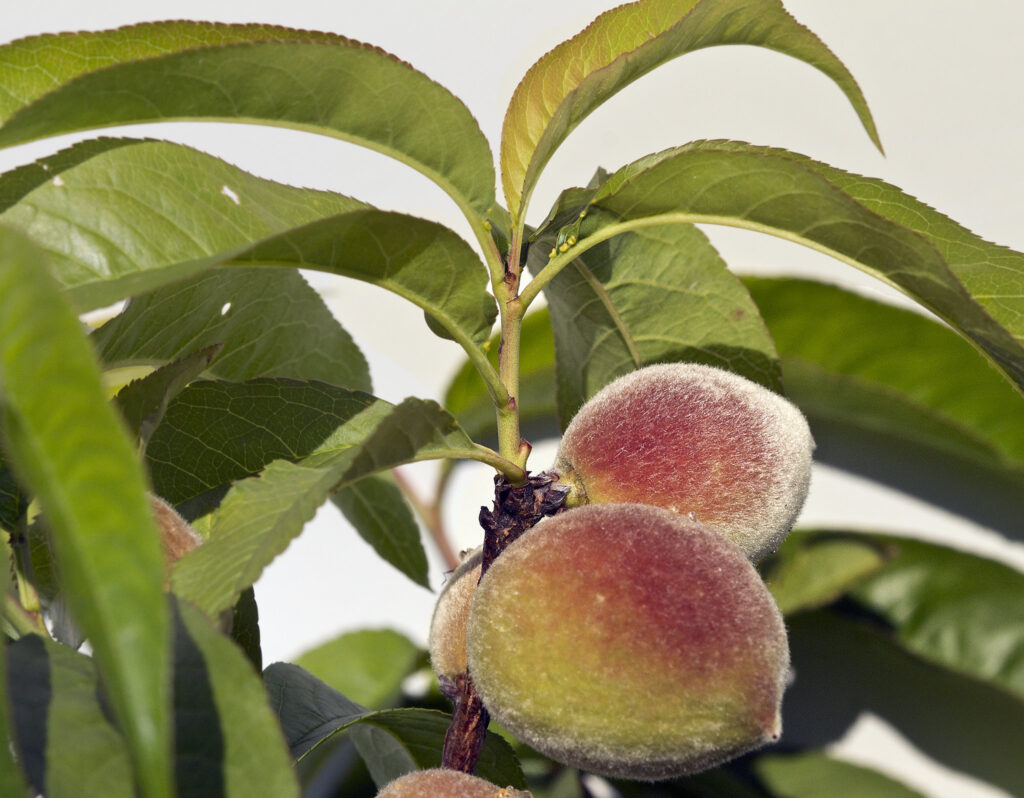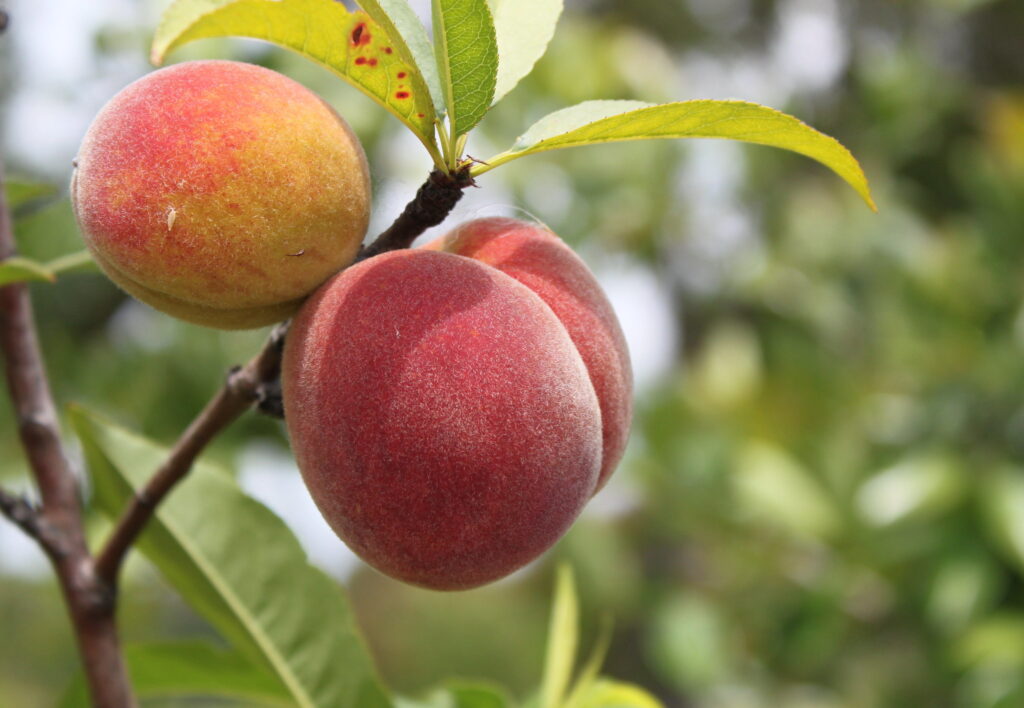The peach was first cultivated in China, thousands of years ago. Cultivation became quite common throughout Asia, where they are now widespread. They were introduced to ancient Greece and Persia by the fourth century BC and were grown in Ancient Rome in the first century AD. They spread to Europe in the Middle Ages and were first introduced to North America in colonial times. They were pretty rare at first until commercial peach production in the US started in the 1800s.
Growing Peaches
The main types of peaches fit into the categories of freestone and clingstone. This refers to the peach pits, and how much they stick to the flesh of the peach. Freestone peaches are good for baking because the pit comes right out when the peach is cut. Clingstone types are great for eating raw! They are also usually a bit more tart than the freestones. Color is the usual indicator of peach types and flavors, and white and yellow peaches include both freestone and clingstone varieties. White peaches are usually sweeter than yellow ones, with a few specific exceptions. Nectarines are a variety of peaches. They are the same species and can even sometimes grow on the same tree! The donut peach is a newer type of clingstone peach. These very sweet peaches are flatter but still round, and are shaped somewhat like donuts.

Peaches are a great source of Vitamin C, and also a good source of Vitamin A and beta-Carotene. They are low-calorie and high in fiber. They have a lower concentration of other nutrients like vitamin K, vitamin E, niacin, and potassium. A peach is a delicious fruit that is a great regular part of a healthy diet.
- Peach (Prunus persica)
- Perennial
- Full sun (8 hours/day minimum)
- Soil acidity: neutral to slightly acidic (6.0-7.0)
- Well-drained, loamy and fertile soil (avoid standing water)
- Garden planting:
Trees should be planted 20 feet apart
The hole should be a bit wider and deeper than the pot or the root spread
Peach trees can be grown from seed – but will not bear fruit for several years.
- Climate Zones 4 to 10 (Standard varieties best in 6 to 8)
- Container planting:
Choose dwarf stock, smaller trees are best for containers.
Large container, at least 5 gallons or larger
Use garden soil and compost, not potting soil
- Water when needed, don’t overwater
How to Plant Peach Trees
When planting a peach tree, choose the type that is best for your climate. The preferred climate zones for peach trees are 6-8, but some varieties are good from zone 4 (colder) to zone 10 (warmer). If you live in a colder or warmer climate zone, be sure to get the right type for your area. “Chill hours” refer to a need for winter chill, defined as hours between 32 and 45 degrees °F during the tree’s dormant period. The tree needs these chill hours to flower and produce fruit in spring and summer. Most peaches need 500 to 1200 chill hours per year. Many varieties of “low chill” types exist that can grow well in warmer areas, these sometimes need as few as 150 hours per year. Be sure to check what type you are growing for the best results.
Peach trees need a lot of sunlight! Partial shade can inhibit growth and fruit production. Also, ensure that the soil drains well. Low areas where water pools are not the best locations for peaches. Also, provide some shelter or protection from harsh winds. Some varieties get quite large, and if unpruned can be up to 25 feet tall. Keeping them pruned will allow you to control the height. Garden peach trees should be pruned to be somewhere between 12 and 15 feet tall at full growth. Pruning the tree annually, preferably in late winter, is very important. As the tree matures, encourage three equally spaced branches to grow, and trim the topmost branches to control the height. Peach trees are self-pollinating, and can be grown singly. If you do plant multiple trees, ensure to keep standard-sized varieties at least 20 feet apart, and dwarf-type trees 12-15 feet apart.

Peach trees should be planted in late winter, or early spring. Dig a hole that is big enough for the roots. Bare-rooted trees or potted trees purchased from a market are both fine. The hole should be a bit larger than the width and height of the roots. Spread the roots out, with a good amount of composted garden soil underneath them. One thing to look out for with potted trees, is roots that have curled around inside the pot. Roots should usually not be pruned, but this is an exception since the roots do need to spread out. Cleanly cut off any single roots that circle around the base of the tree. If you purchase a grafted tree, plant it so that the grafted branch is on the north side, away from the sun, and ensure that the grafts are a good hand’s width above the ground once it’s planted. If you use fertilizer, don’t fertilize when planting. Peach trees should be fertilized about two months after planting the first year, and then in the summer each year thereafter.
Growing Peaches in Containers
Peaches (and nectarines) can also be grown in containers. It’s important to choose a dwarf-type tree, to keep the tree at a manageable size (up to 6 feet tall at full growth). This is a good solution if you don’t have a big garden, and it will allow the tree to be moved to take advantage of the sunlight. Fertilization is more important for peach trees in containers. Use a high-nitrogen fertilizer. Commercial fertilizers are convenient, but organic fertilizers including soybean meal or cottonseed meal can be just as effective.
Peach trees can also be started from seeds. Determine the type of peach it is, to ensure that your climate will be good for the peach tree. Peach pits can be planted in the fall, and allowed to germinate naturally in the spring, but it may be best to start the tree indoors. To start, wait until the start of winter in December, and soak several peach pits of a few different varieties in water for a few hours. Put each pit singly into a plastic container or plastic bag, put it in the refrigerator, and keep it chilled in the high 30s °F. If it germinates (which is not certain), it will take a month or more. Plant it in a medium-sized pot, about 4 inches deep, and let it sprout and grow over the rest of the winter. Once past the last frost date, plant it. It will grow normally, though it will take a few years for it to get to fruit-bearing age!
Grapes, asparagus, garlic, and onion are good companions to plant under or near a peach tree. Peach trees and these other plants will help each other with nutrients in the soil. Garlic can help to repel common pests like peachtree borers. Other pests that can bother peaches include aphids, leafhoppers, ring nematodes, and root-knot nematodes. Herbs like fennel, cilantro, and yarrow can attract ladybugs. Plant these in the area, but well away from the tree. Ladybugs are the best solution to aphids!

Peach Tree Common Problems
Common diseases for peach trees include fungal diseases like brown rot, peach scab, peach leaf curl, and powdery mildew, as well as some bacterial infections like bacterial canker and bacterial spot. Anti-fungal treatments can help with many fungal diseases. Neem oil spray can be effective, and it’s organic. The best way to avoid problems with all of these is by prevention. Look for disease-resistant varieties, keep your tools clean, ensure to keep the tree pruned of any dead branches and dead fruit, keep the tree free of surrounding weeds, and use a preventative fruit tree spray in the early spring before it blooms.
Peaches are ready to harvest when they are completely yellow (or white). Look carefully and make sure that there are no green spots. Ripe peaches will separate from the branch with a gentle twist. They should be used quickly but can be stored in the refrigerator for several days.

Contact Author
 info@gardensavvy.com
info@gardensavvy.com Recent Posts
- Smart Gardening: How Technology Is Revolutionizing Horticulture
- Understanding Gardening Zones: What You Need to Know
- The Right Tools For Your Gardening And Landscaping Needs
- Maximizing Your Harvest: Square Foot Gardening Chart for Beginners
- Holiday Garden Scents: Plants for Natural Aromatherapy in Your Home









